Flora Of Ramgarh Crater, Baran District, Rajasthan with Ethnobotanical Notes and Highlight on Related Issues
Dr. Satish Kumar Sharma
Assistant Conservator of Forests (Retd.)
14-15, Chakri Amba, Rampura Circle, Udaipur, Rajasthan
Anurag Bhatnagar
Dy. Conservator of Forests,
Wildlife Division, Kota, Rajasthan
Praveen Singh
Field Biologist,
Tiger Watch, Sawai Madhopur, Rajasthan
Dr. Dharmendra Khandal
Conservation Biologist
Tiger Watch, Sawai Madhopur, Rajasthan
Ramgarh crater is a prominent meteorite impact crater, located on the Vindhyan Plateau near Ramgarh village in Baran District, southeastern Rajasthan. Geologically significant, the crater spans a forested region, now managed under the jurisdiction of the Kishanganj Forest Range, Baran Forest Division. Earlier, this area was managed as a territorial forest but now has been declared as a Conservation Reserve by the Government of Rajasthan through notification F/4(12)/Forest/2017, dated March 3, 2023. The details of forest blocks and area is given below in the Table 1.
Table 1: Area details of Ramgarh Conservation Reserve.
S. No. | Forest Block | Forest Land Category | Area (ha) |
1 | Ramgarh | Protected Forest | 1440.50 |
2 | Kunji Suwans | Protected Forest | 2368.34 |
Total | 3808.84 |
The area is important from history, culture, archeology, geology and forestry point of view. Historically, apex predators such as the tiger (Panthera tigris) and leopard (Panthera pardus) were once reported in the region, though they are now locally extinct.
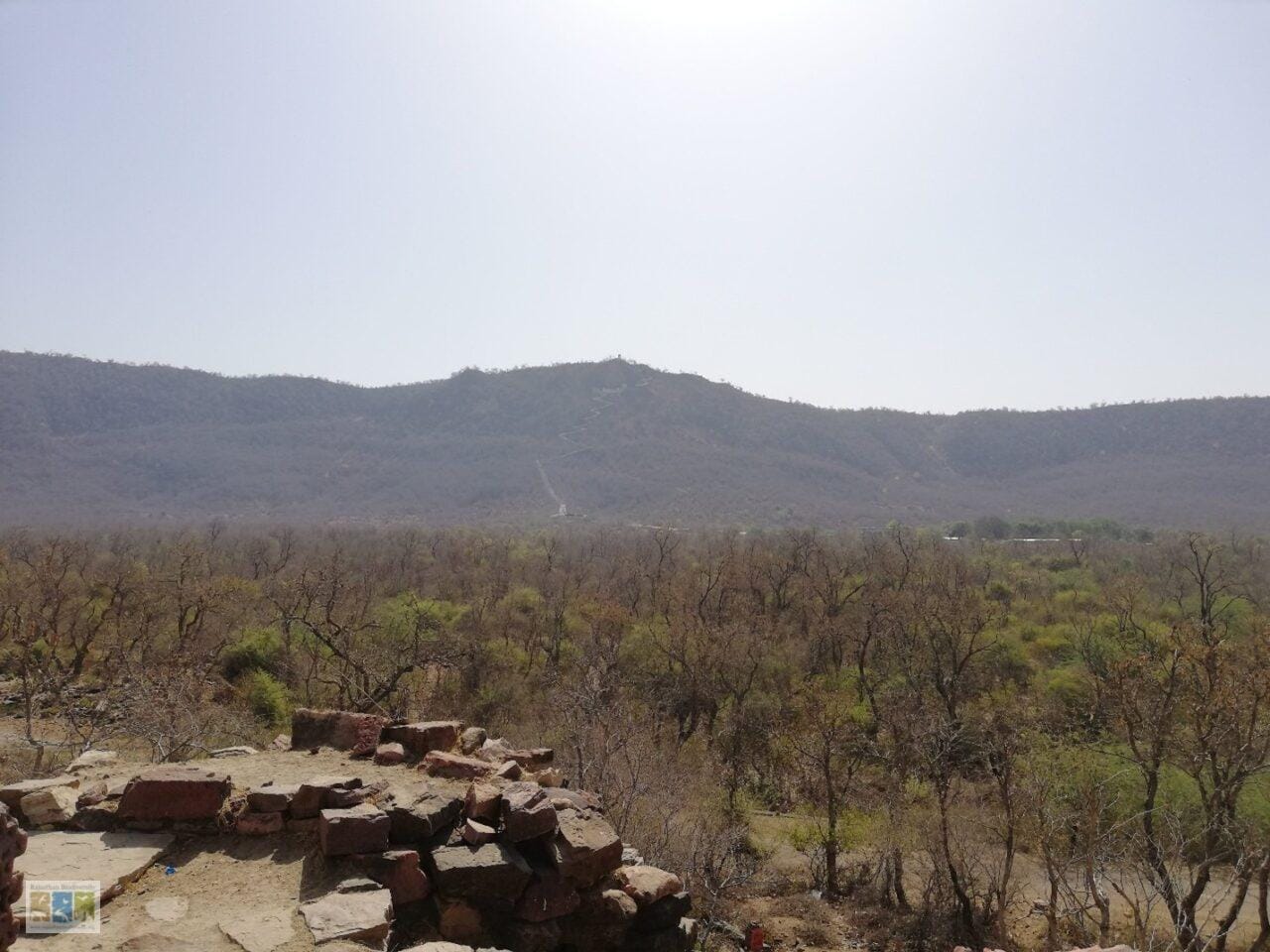
Figure 1: View of the Dhonk (Anogeissus pendula) forest on eastern inner hill slope and Butea monosperma dominated forest in foothills (photo taken from ruins of the Bhand Deora).
The present-day mammalian fauna includes the Northern Plains Langur (Semnopithecus entellus), Indian Wild Pig (Sus scrofa), Jungle Cat (Felis chaus), Common Palm Civet (Paradoxurus hermaphroditus), Small Indian Civet (Viverricula indica), Grey Mongoose (Herpestes edwardsii), Ruddy Mongoose (H. smithii), Striped Hyena (Hyaena hyaena), Golden Jackal (Canis aureus aureus), Indian Hare (Lepus nigricollis), Indian Crested Porcupine (Hystrix indica), House Shrew (Suncus murinus), Five-striped Squirrel (Funambulus pennantii), Indian Gerbil (Tatera indica), and Indian Monitor Lizard (Varanus bengalensis). The area also supports a rich assemblage of avifauna, reptiles, butterflies, and moths.

Figure 2: A juvenile Bengal Monitor Lizard (Varanus bengalensis) (photographed at the eastern bank of Pushkar Talab on July 15, 2025).
Ramgarh Crater is equally notable for its architectural and spiritual heritage. Noteworthy sites include the Ramgarh Fort, Bhand Deora temple complex, Harchand Ji Ki Chhatri, Annapurna and Krishnai Mata Ji Temples, Kachkaran Ki Baori, Brahm Chetan Kund, and Ramgarh Mata Temple. Several water bodies, such as Nola, Pushkar Talab (Pokhar), Bada Talab (Ramgarh Talab), and Mala Ki Talai, dot the crater landscape. According to oral histories, rulers of Kota State once frequented Mala Ki Talai for royal hunting expeditions (Dr. Madhusudan Vaishnaw, pers. comm., June 20, 2024).
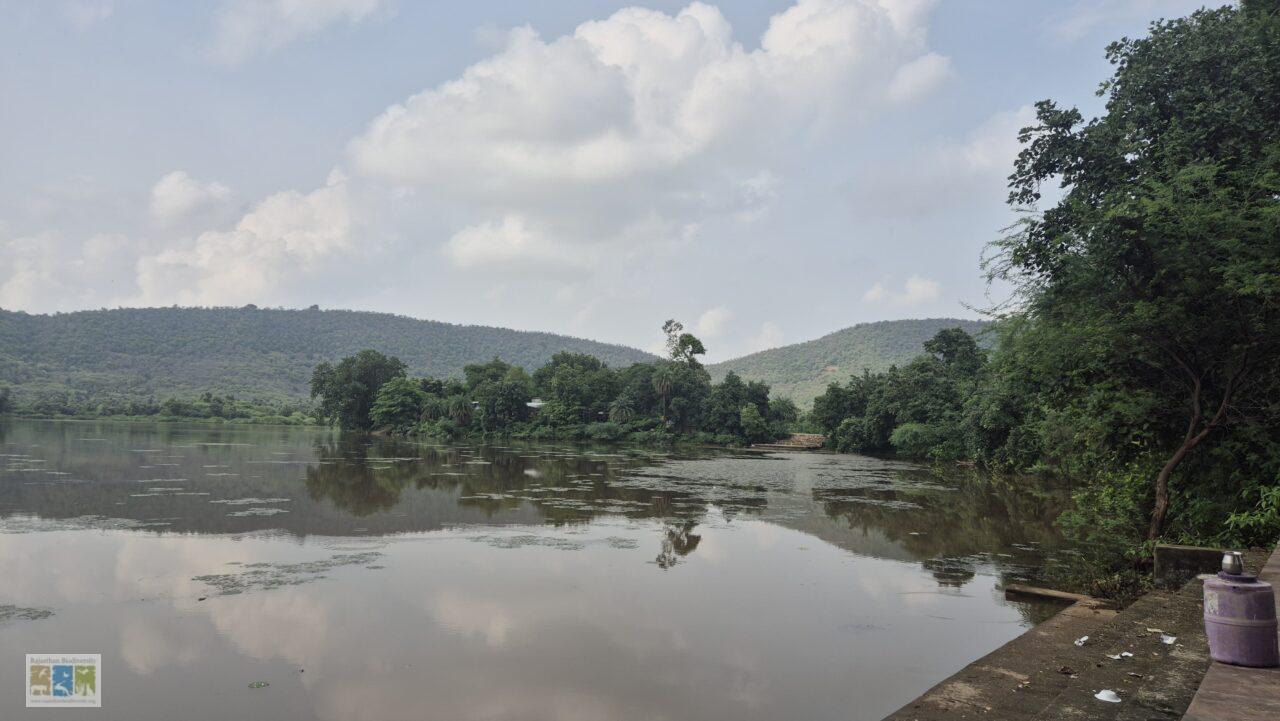
Figure 3: View of Pushkar Talab as seen from the vantage point behind the ruins of the Bhand Deora Temple.
Significantly, Pushkar Talab within the Ramgarh Crater has been designated as one of the 44 ‘Notified Wetlands’ by the Government of Rajasthan, highlighting its ecological importance and hydrological value within the regional landscape.
The broader Hadoti region is relatively well-documented for its prehistoric rock art and unique geological specialties (Abbas, 2021; Nagar et al., 2017; Pandey et al., 2024). However, the Ramgarh Crater, despite its ecological and cultural significance, has received limited focused scientific attention (Aswathi et al., 2012). Floristic studies covering the broader Hadoti zone are available (Sharma, 2002), and a comprehensive overview of the vegetation across Kota, Bundi, Jhalawar, and Baran districts is provided in “The Flora of Rajasthan” (Sharma, 2022). However, a dedicated botanical inventory specifically focused on the Ramgarh Crater remains absent.
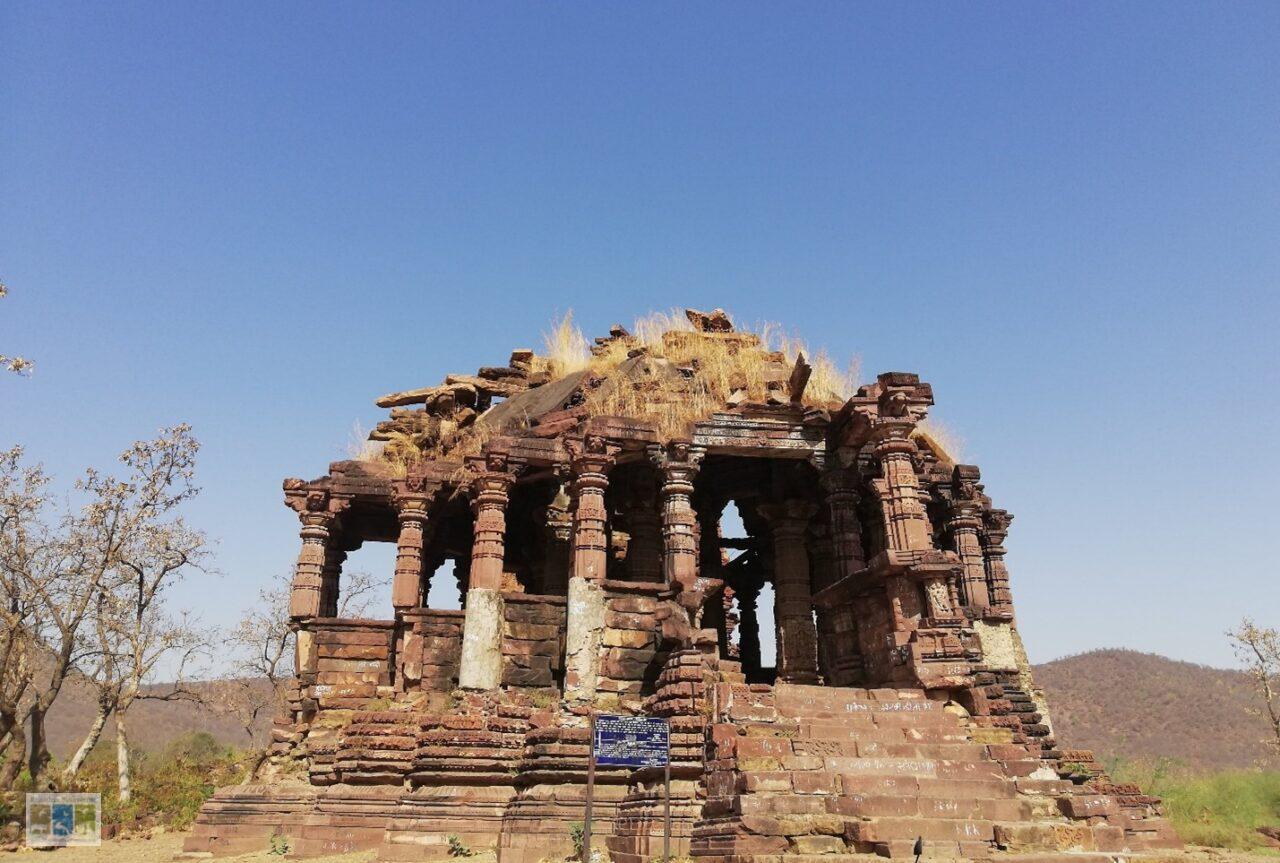
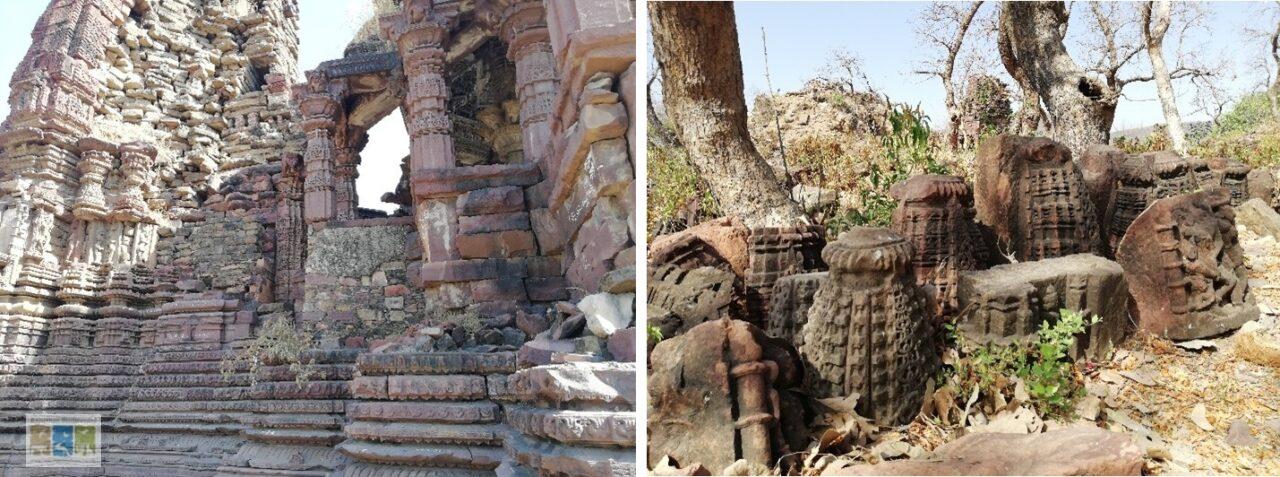
Figure 4: Ruins of the Bhand Deora Shiva Temple. The upper section shows the remains of the sanctum (Garbhagriha); the bottom left displays the outer wall of the sanctum, while the bottom right depicts scattered architectural remnants lying behind the Garbhagriha.
To address this gap, extensive floristic surveys were conducted between 2023 and July 2025. These investigations aimed to document the floral diversity of the crater across different seasons and provide foundational data for future ecological and conservation assessments.
Table 2: Dicot flora of Ramgarh crater
S.N. | Family | Latin name of plant | H* | Location | Status | Remark |
1 | Annonaceae | Annona squamosa | S | Near eastern bank of Pushkar Talab | Less common | Growing in patches |
2 | Monispermaceae | Cissampelos pareira
| TS | Growing among bushes | Relatively common |
|
|
| Tinospora cordifolia | CS | Climbing on Prosopis juliflora | Relatively common | Hanging assimilatory roots are visible here and there |
|
| Cocculus hirsutus | SS | Growing among bushes | Relatively common |
|
3 | Nymphoeaceae | Nymphoea nauchali | H | Bada talab and Puskar Talab | Common |
|
4 | Nelumbonaceae | Nelumbo nucifera | H | Bada Talab | Common | Growing towards shore area |
5 | Papaveraceae | Argemone mexicana | H | Downstream of Bada Talab | Common |
|
6 | Capparaceae | Capparis decidua | S/ST | Dotted everywhere in open well drained pockets | Common |
|
|
| C. sepiaria
| SS | Dotted everywhere | Common
|
|
|
| Crateva odansonii | T | Foot hills | Rare |
|
7 | Flacourtiaceae | Flacourtia indica | S/ST | Dotted | Less common |
|
8 | Malvaceae | Abutilon indicum
| US | Dotted
| Less common |
|
|
| Hibiscus caesius
| H | Dotted among bushes | Relatively common | Become visible after monsoon season when it flowers |
|
| H. micranthus | S | Dotted | Less common |
|
9 | Sterculiaceae | Sterculia urens | T | Upper reaches of the hills | Rare |
|
10 | Tiliaceae | Corchorus aestuans | H | Near Bada Talab | Less common |
|
|
| C. capsularis
| H | Near Bada Talab | Less common |
|
|
| C tridens | H | Near Bada Talab | Less common |
|
|
| Grewia flavescens | S | Growing below the Anogeissus pendula crop | Less common |
|
|
| G. tenax | S | A bush of stony area | Less common |
|
11 | Oxalidaceae | Oxalis corniculate | H | Edges of both the water bodies | Abundant |
|
12 | Rutaceae | Aegle marmelos | T | Seen in valley area | Less common |
|
13 | Simaroubaceae | Ailanthus excelsa | T | On the way to Ramgarh Mata temple | Rare | Visible from distance owing to large sized leaves |
14 | Balanitaceae | Balanites aegyptiaca | T | Soil erosion prone compact areas | Common | A species which suckers profusely |
15 | Burseraceae | Boswellia serrata | T | Upper reaches | Less common |
|
16 | Meliaceae | Azadirachta indica
| T | Growing among bushes near Goshala | Less common
|
|
|
| Melia azedarach | T | Near Goshala | Rare |
|
17 | Rhamnaceae | Ziziphus glabrata | T | Dotted | Less common |
|
|
| Z. mauritiana | T | Dotted | Less common |
|
|
| Z. nummularia | S | Dotted along the road | Less common |
|
|
| Z. xylophyrus |
| Dotted on hill slopes | Less common |
|
18 | Vitaceae | Cayratia carnosa | C | Climbing straight on the thick-stemmed trees like Madhuca indica | Common | A rainy season plant. Starts appearing before onset of monsoon. It perennates through its beaded or moniliform roots |
19 | Sapindaceae | Cardiospermum helicacabum | C | Among bushes | Common | A rainy season plant |
20 | Anacardiaceae | Lannea coromadelica
| T | Present from upper reaches to foothills. | Common
| Also seen growing on ancient buildings of temples and fort. |
|
| Mangifera indica | T | Eastern edge of Pushkar Talab and near Goshala | Grow in groves |
|
21 | Moringaceae | Moringa oleifera | T | Dotted | Less common |
|
22 | Fabaceae | Abrus precatorius | TH | Among bushes | Common |
|
|
| Alysicarpus vaginalis | H | Growing as ground flora | Common
|
|
|
| Butea monosperma | T | Foot hills | Abundant
| Growing as 5/E5– Butea Forest in the area. |
|
| Clitoria ternatea | TH | Growing among the bushes near spillover of Bada Talab | Less common
|
|
|
| Crotalaria medicagenia | H | Open areas | Common | A rainy season plant |
|
| Desmodinm triflorum | H | Creeping here and there on the ground floor | Common
|
|
|
| Galactia tenuiflora | TH | Among bushes near Bhand Deora and eastern bank of Pushkar Talab | Relatively common
|
|
|
| Indigofera linifolia | H | Quite visible during monsoon and post monsoon period | Common
|
|
|
| I. linnaei | H | Quite visible during monsoon and post monsoon period | Common |
|
|
| Mucuna prurita | TH | Visible during monsoon and post monsoon period | Common |
|
|
| Rhynchosia minima | TH | Among bushes | Common |
|
|
| Tephrosia villosa | US | During rainy season becomes visible in open areas | Less common |
|
|
| T. purpurea | H | During rainy season becomes visible in open areas | Less common |
|
23 | Caesalpiniaceae | Bauhinia racemosa
| T | On the way to Ramgarh Mata temple and near eastern bank of Pushkar Talabs | Rare
|
|
|
| Cassia fistula | T | Near eastern bank of Pushkar Talabs | Rare
|
|
|
| Cassia pumila
| H | Open areas | Less common |
|
|
| Cassia sophera / Senna sophera
| S | Near eastern Ghat of Pushkar Talab. Growing under the shade of Madhuca indica | Less common | Grow in patches
|
|
| Cassia tora/ Senna tora
| H | Grow in open area | Common
|
|
|
| C. uniflora/ Senna uniflora | H | Open area | Common | This species is spreading at fasti pace |
|
| Tamarindus indica | T | Near eastern edge of Pushkar talab | Rare |
|
24 | Mimosaceae | Acacia catechu
| T | Hill slopes | Common |
|
|
| A. leucophloea | T | Hill slopes (where degradation is prevailing) and foot hills. Visible along the sides of whole road net work | Common
|
|
|
| A. nilotica indica
| T | Foothills and road side ditches | Less common
|
|
|
| Dichrostachys cinerea | S | Foothills and lower slopes | Less common |
|
|
| Mimosa himalayna
| S | Road sides
| Less common |
|
|
| Prosopis juliflora | T | Whole valley and foot hills are badly affected | Abundant |
|
25 | Combretaceae | Anogeissus pendula / Terminalia pendula | T | A dominant species luxuriantly growing on hill slopes and foot-hills. | Abundant | Making 5/E1 and 5/E/DS1 forest types on hill slopes and stoney foot hills |
26 | Myrtaceae | Syzygium cumini | T | Near Goshala | Rare |
|
27 | Onagraceae | Ludwigia adscendens | H | Bada Talab | Less common |
|
28 | Trapaceae | Trapa natans | H | Pushkar and Bada Talab waters | Common |
|
29 | Cucurbitaceae | Cucumis melo var. agrestis | C | On the walls of Bhand Deora | Less common | Rainy season plant |
|
| Diplocyclos palmatus
| H | Among bushes | Common during rainy season | Rainy season plant |
|
| Luffa acutangula
| C | Among bushes | Less common
| Rainy season plant |
|
| L. echinata | C | Among bushes | Common | Rainy season plant |
|
| Momordica charantia | C | Among bushes | Common | Rainy season plant |
|
| M. dioica | C | Among bushes | Less common | A dioicous plant of rainy season. Start appearing before on set of monsoons through the underground tubers |
|
| Trichosanthes cucumeriana | C | Among bushes | Abundant | Rainy season plant |
30 | Cactaceae | Opuntia elatior | S | On the way to Bhand Deora | Less common | Havily naturalize in many pockets of Baran district |
31 | Aizoaceae | Trianthema portulacastrum | H | Quite visible during rainy season in open areas | Common |
|
32 | Rubiaceae | Borreria articularis | H | Visible during rainy season on forest floor | Common
|
|
|
| B. pusila
| H | Visible during rainy season on forest floor | Less common |
|
|
| Mitraguna parvifolia | T | Hill slopes and foot hills | Less common |
|
33 | Asteraceae | Ageratum conyzoides | H | Bordering area of Pushkar Talab and Bada Talab | Common
|
|
|
| A haustonianum | H | Bordering area of Pushkar Talab and Bada Talab | Less common |
|
|
| Bidens biternata
| H | Open areas and old buildings | Common
|
|
|
| Caesulia axillaris | H | Bordering Bada Talab | Less common |
|
|
| Echinops eclinatus
| H | Near Bhand Deora and at many places along the road | Less common
|
|
|
| Eclipta prostorey | H | Bordering Bada Talab | Less common |
|
|
| Parthenium hysterophorus | H | Occupying open places | Abundant |
|
|
| Tridax procumbens
| H | Open areas and road side | Abundant
|
|
|
| Vernonia cineria | H | Open areas | Less common |
|
|
| Xanthium strumarium | H | Road sides | Common |
|
34 | Sapotaceae | Madhuca indica
| T | Present near the eastern shore of Pushkar Talab
| Growing singly and in groves
|
|
|
| Manilkara hexandra | T | Few trees dotted in the area | Rare |
|
35 | Ebenaceae | Diospyros cordifolia
| T | Dotted in foot hills | Less common |
|
|
| D. melanoxylon | T | Doted in foot hills & lower hill slopes | Less common |
|
36 | Apocynaceae | Carissa spinarum
| S | Near Bhand Deora | Rare
|
|
|
| Catharanthus pasillus
| H | Grow in open areas during rainy season | Common
|
|
|
| Wrightia tinctoria | T | Hill slopes | Rare |
|
37 | Asclepiadacace | Calotropis procera
| S | Open area along the road | Less common |
|
|
| Oxystelma secamone | TH | Downstream of Bada Talab | Less common |
|
|
| Pergularia daemia | TU | Among bushes | Less common |
|
|
| Wattakaka volubilis | TS | Dotted | Rare | Climbing on trees |
38 | Priplocaceae | Cryptostegia grandiflora | SS | Down stream of the Bada Talab | Rare |
|
|
| Hemidesmus indicus | SU | Dotted here and there on the forest floor | Rare |
|
39 | Ehretiaceae | Cordia dichotoma | T | Near eastern edge of Pushkar Talab | Less common |
|
|
| Ehretia laevis | T | Dotted | Less common |
|
40 | Convolvulaceae | Evolvulus alsinoides | H | Open areas | Less common |
|
|
| E. nummularius
| H | Bordering both water bodies | common
|
|
|
| Ipomoea carnea ssp. fistulosa | S | Eastern shore of Bada Talab
| Common |
|
|
| I. dichora
| TH | Dotted among the bushes during rainy season | Common |
|
|
| I. nil | TH | Can be seen among the bushes during rainy season | Common |
|
|
| I. obscura | TH | Grow among bushes during rainy season |
Common
|
|
|
| I. pes-tigridis | TH | Grow among bushes during rainy season | Common
|
|
|
| Merramia emarginata | H | Bordering shore zone of both the water bodies | Common |
|
|
| Rivea hypoaraterifornis | CH | Growing among the bushes | Less common |
|
41 | Cascutaceae | Cuscuta chinensis
| H | A parasite on herbs and shrubs | Less common
|
|
|
| C. reflexa | H | Near Bhand Deora | Less common |
|
42 | Solanaceae | Datur innoxia
| S | Near Bhand Deora | Less common |
|
|
| D. stramonium
| H | Near Bhand Deora | Rare
|
|
|
| Solanum xanthocarpum | H | Along the road leading to Ramgarh Mata temple | Less common |
|
43 | Scrophulariaceae | Bacopa monnieri
| H | Edges of both the ponds | Common
|
|
|
| Lindenbergia muraria | H | Fort wall
| Less common |
|
|
| Verbascum chinense | H | Walls of Bhand deora | Less common |
|
44 | Bignoniaceae | Oroxylum indicum | T | Seen 2 trees and their many suckers in Shobhagpura village towards southern outskirts of the crater | Rare (?) (This species is included here on the authority of the local villagers) | Villagers were of opinion that the seeds were brought from crater area and sown in the agriculture field. Locally the species is called Muwasa |
45 | Pedaliaceae | Sesamum mulayanum | H | Can be seen during rains in open areas | Common |
|
46 | Martyniaceae | Martynia annua | H | Grow in patches in open area | Less common | Being grazing hardy plan remain undamaged and all the fruits drop below the mother plant after maturation. All fallen seeds germinate during next rain making a clump |
47 | Acanthaceae | Aahatoda zeylanica
| S | Making extensive thickets in foothill zone
| Abundant
| A grazing hardy species occupying most of foot hill area |
|
| Barleria prionits
| US | Seen along the road sides | Less common |
|
|
| Elytraria aculis
| H | Common under Capparis sepiaria and Anogeissus pendula | Very common |
|
|
| Indoneesiella echioides | H | Seen on the walls of Bhand devra | Less Common | Grow on the walls as ruderal species. Also grow in rocky areas. Remains visible only during monsoon season |
|
| Justicia procumbens | H | Quite visible during rains | Common |
|
|
| Peristrophe paniculata | H | Quite visible during rains | Abundant |
|
48 | Verbenaceae | Lantana camara
| S | Invasive in the foot hill zone | Common
|
|
|
| Phyla nodiflora | H | Banks of both the water bodies | Less common |
|
49 | Lamiaceae | Leucos aspera | H | Open area during rainy season | Less common |
|
50 | Nyctaginaceae | Boerhavia diffusa | H | Open grassy patches | Common |
|
51 | Amaranthaceae | Achyranthes aspera | H | Affected whole foothills. Also growing as ruderal species | Abundant |
|
|
| Digera muricata
| H | Grassy patches during rains | Less common
|
|
|
| Pupalia lappacea | H | Grow among bushes during rains | Less common |
|
52 | Chenopodiaceae | Chenopodium murale | H | Grow in moist areas during winter | Less common |
|
53 | Polygonaceae | Polygonum glabrum | H | Wet edges of both the ponds | Less common
|
|
|
| P. plebeium
| H | Drying edges of both the ponds | Less common
|
|
|
| Rumex dentatus | H | Grow in moist areas during the winter | Common |
|
54 | Euphorbiaceae | Baliospermum montanum
| H | Below the Mahuwa and mango trees | Less common
|
|
|
| Chrozophora rottleri | H | Drying bed of the ponds | Less common |
|
|
| Euphorbia hirta | H | Dotted | Common |
|
|
| E. heyneana | H | Dotted | Common |
|
|
| Jatropha gossypifolia | S | near Goshala | Less common |
|
|
| Kirganelia reticulata
| SS | Moist-shady places at periphery of both the ponds | Less common |
|
|
| Phyllanthus fraternus
| H | seen grown on Bhand Deora during rains | Less common
|
|
|
| Ricinus communis
| ST | Seen near eastern shore of Puskar Talab | Rare
|
|
|
| Securinega leucopyrus | S | Foot hills
| Less common |
|
55 | Ulmaceae | Holoptelea integrifolia | T | Dotted | Less common |
|
56 | Moraceae | Ficus benghalensis
| T | Eastern shore of Pushkar Talab. Seen growing as epiphyte also | Less common
|
|
|
| F. hispida
| S | Growing in shady wet localities | less common
|
|
|
| F. racemosa
| T | growing near eastern shore of Pushkar Talab | rare
|
|
|
| F. religiosa
| T | Dotted. Seen growing as epiphyte also | less common
|
|
|
| F. virens
| T | seen growing as epiphyte | rare |
|
Table 3: Monocot flora of Ramgarh crater
S.no. | Family | Latin name of plant | H* | Location | Status | Remark |
1 | Hydrocharitaceae | Hydrilla verticillate | H | Pushkar Talab & Bada Talab | Common |
|
2 | Dioscoreaceae | Dioscorea bulbifera | TH | Dotted. Visible during rainy season. | Rare |
|
3 | Liliaceae | Asparagus racemosus | SU | Dotted among bushes | Common
|
|
Urginea indica | H | Dotted in well drained areas | Less common |
| ||
4 | Commelianceae | Commehina benghalensis | H | Common during rainy season on the ground and buildings | Common |
|
C. forskalaei | H | Common during rainy season | Common |
| ||
5 | Arecaceae | Phoenix sylvestris | T | Eastern shore of Pushkar Talab | Less common |
|
6 | Lemnaceae | Lemna perpusilla | H | Pushar Talab & Bada Talab | Less common
|
|
Spirodela poiyrhiza | H | Pushar Talab & Bada Talab | Common |
| ||
Wolffia microscopica | H | Pushar Talab & Bada Talab | Common |
| ||
7 | Potamogetonaceae | Potamogeton pectinatus | H | Pushar Talab & Bada Talab | Less common |
|
8 | Crperaceae | Cyperus triceps | H | Growing with grasses
| Less common |
|
Fimbristylis falcata | H | Edges of both the ponds | Less common |
| ||
9 | Poaceae | Apluda mutica
| H | Among bushes and below the trees | Abundant |
|
Aristida adscensionis
| H | Open compact soil zone | Common |
| ||
Arthraxon lanceolatus
| H | Under Mahuwa trees near eastern edge of Pushkar Talab | Less common |
| ||
A. lancifolius
| H | Under Mahuwa trees near eastern edge of Pushkar Talab under Mahuwa trees | Less common |
| ||
Bothriochloa pertusa
| H | Growing among bushes | Less common |
| ||
Brachiaria ramosa | H | Open areas | Common |
| ||
B. raptans | H | Open areas | Common |
| ||
Choris dolichostachya
| H | On the walls of Bhand Deora and stony substratum below the Dhok trees | Rare |
| ||
C. virgata
| H | Open areas and among bushes | Less common |
| ||
Chrysopogon fulvas | H | Stony-rocky terrain of hill slopes | Less common |
| ||
Cynodon dactylon | H | Moist open areas and banks of streams towards foothills | Abundant |
| ||
Dactylocteninum aegyptium | H | Open area | Abundant |
| ||
Dendrocalamus strictus | S | Upper reaches of southern inner slope | Less common | Growing making small patches (5/E9 Dry Bamboo brakes) | ||
Dicanthium annulatum | H | Growing among the bushes | Less common |
| ||
Echinachloa colona | H | Edges of both the water bodies | Less common |
| ||
Eragrostiella bifaria | H | Open stony patches | Less common |
| ||
E. japonica | H | Open stony patches | Less common |
| ||
Heteropogon contortus | H | Areas having better soil thickness | Less common |
| ||
Melanocenchris jacquemonti | H | Compact open area suffering from erosion | Less common |
| ||
Oplismenus burmannii | H | Shady places under Mahuwa and Mango groves | Common |
| ||
Oropetium thomaeum | H | Rocky areas covered by thin layer of the soil | Less common |
| ||
Oryza rufipogon | H | Ditches along the road leading to crater | Less common |
| ||
Pennisetum orientale | H | Among busses of foothills | Less common |
| ||
Phalaris minor | H | Wet patches | Less common | A winter season grass | ||
Sehima nervosum | H | Among the bushes | Less common |
| ||
Setaria verticillata | H | Shady places under Mahuwa and Mango groves | Less common |
| ||
Sporobolus diander | H | Compact open patches | Less common |
| ||
S. ioclados | H | Compact open patches | Less common |
| ||
Tetrapogon tenelus | H | Degraded compact patches | Less common |
| ||
|
| Vetiveria zizanioides | H | Low lying areas | Less common |
|
* Habit
Tree: T= Tree (Tall, medium sized), ST= Small tree/ Under tree
Shrub: S= Shrub, TS = Twining shrub, CS= Climbing shrub, SS= Scandent shrub/ Straggling shrub, TU= Twining undershrub, SU=Scandent undershrub, US= Undershrub,
Herb: H= Herb, TH= Twining herb, C= Climber
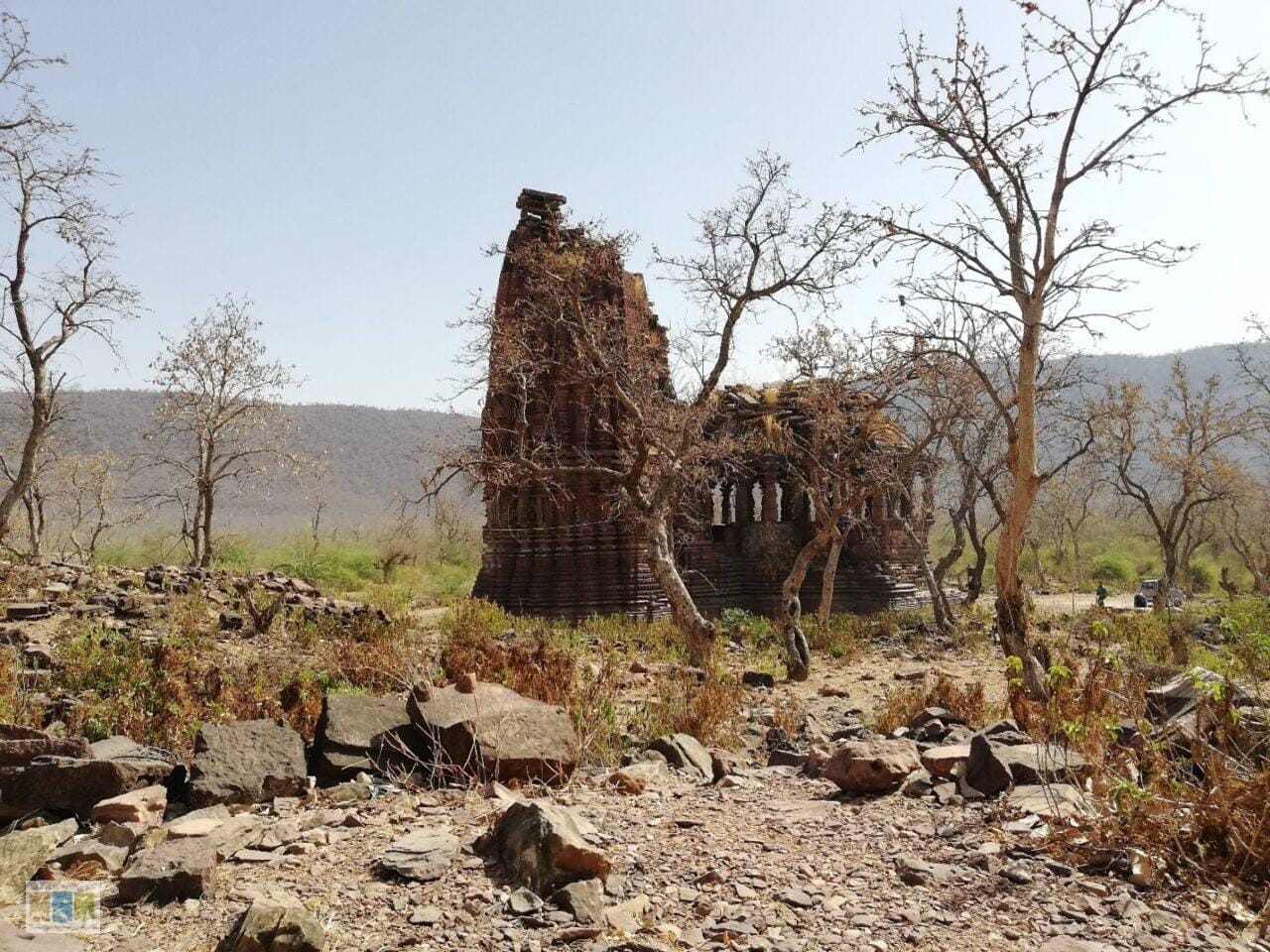
Figure 5: View of the Shiva temple as seen from the surrounding ruins at Ramgarh Crater.
Summary:
A total of 197 vascular plant species belonging to 65 families and 156 genera were documented during floristic surveys conducted between 2023 and July 2025. summary of the various taxa recorded during the present study is depicted below:
Table 4: Summary of Taxa
S. No. | Class | No. of Families | No. of Genera | No. of Species |
1 | Dicotyledons | 56 | 119 | 154 |
2 | Monocotyledons | 9 | 37 | 43 |
| Total | 65 | 156 | 197 |

Figure 6: Variations in Dhonk (Anogeissus pendula) forest growth forms observed at Ramgarh Crater.
Main Forest Types:
Many forest types are confined to Ramgarh crater. Tropical dry deciduous forests are prevailing in the area. The biggest forest type of the area is 5/E1– Anogeissus forest which is present on inner and outer slopes of the crater ring. Due to heavy anthropogenic pressure, degradation is seen on the slopes, especially towards outer slopes and 5/E1 – forest has converted into 5/E/DS1–Anogeissus scrub at places. The 5/E5– Butea forests is present in the ‘bowl’ of the hilly ring. Once 5/E9 – Dry Bamboo brakes were prominent in the area but due to anthropogenic pressure, bamboo forest is under pressure. Still a beautiful patch of bamboo forest is present towards the upper reaches of inner face (northern aspect) in southern direction between Krishnayan Mata Ji and Brhamchaten Kund. This is not a pure patch of Dendrocalamius strictus but it is growing inter mixed with Anogeissus pendula (Terminalia pendula). Northern aspect remains more moist than southern aspect. Due to this moisture difference, northern aspect of southern part of the ring is supporting luxuriant bamboo growth.
Various storeyfication (stratification) patterns are observed across different forest types and localities within this region. The vertical structure of the forest near the eastern shore of Pushkar Talab, particularly near the Pucca Ghat area, is characterized by the following stratification pattern:
Table 5: Storeyfication in Butea dominated foothill forest.
| Storey | Species composition |
| I- Top storey trees | Madhuca indica, Mengifera indica, Phoenix sylvestries, Butea monosperma, Tamarindus indica |
| II- Under storey trees | Diospyros cordifolia, Cassia fistula, Prosopis juliflora, Ehretia laevis, Flacourtia indica |
| IIa- Bamboo | Absent |
| III- Shrubs | Capparis sepiaria, Cassia sophera, Annona squamosa, Lantana camra, Dichrostachys cineria, Mimosa himalayana, Carissa spinarum, Adhatoda zeylanica, Kirganelia reticulata, Ficus hispida |
| IVa- Herbs | Sida acuta, Oxalis corniculate, Alysicarpus vaginalis, Desmodium triflorum, Cassia tora, C. uniflora, Tridax procumbens, Achyranthes aspera, Baliospermum montana, |
| IVb – Grasses | Apluda mutica, Arthraxon lanceolatus, A. lancifolius, Oplismenus burmannii, Seteria verticillate, |
| V – Climbers | Cocculus hirsutus, Cayratia carnosa, Cardiospermum helicacabum, Abrus precatorius, Galactia tenuiflora, Rhynchosia minima, Diplocyclos palmatus, Luffa acutangula, Dioscorea bulbifera |
Density, species diversity, and vertical stratification are more pronounced in the lower zones, where deeper soils and better moisture availability create favourable conditions for vegetation growth, as indicated in Table 5. In contrast, the upper zones, characterized by shallower soils and limited moisture, exhibit comparatively lower species diversity and simpler forest structure. This pattern is particularly evident in the bamboo-dominated forest located in the upper hill slopes, as detailed in Table 6.
Table 6: Vegetation stratification in Bamboo forests on the upper hill reaches
Storey | Species composition |
I & II Storey trees | Anogeissus pandula, Lannea coromandelica, Acacia catechu, Wrightia tinctoria, Ehretia laevis, |
IIa- Bamboo | Dendrocalamus strictus |
III- Shrubs | Grewia flavesens, Ziziphus xylopyrus, Securinega leucopirus, |
IVa- Herbs | Hibiscus caesius, Elatraria acaulis, Indoneesiella echioides, Achyranthes aspera |
IVb – Grasses | Apluda mutica, Chloris dolichostachya, Chrysopogon fulvus, Eragrostiella biferia, Heteropogon contortus |
V – Climber | Asparagus racemohus |
Ethnobotanical notes:
The Ramgarh Crater region historically supported a diverse range of non-timber forest products (NTFPs). Sahariya, the local tribals were more dependent on this resource for their livelihood. In earlier times, the Butea monosperma-dominated forests were a major source of foliage used to make biodegradable leaf plates (pattals) and bowls (daunas). With the advent of disposable plastic and paper alternatives, this traditional practice has significantly declined. Butea flowers were also collected seasonally for their cultural and medicinal significance.
Even today, Cassia tora seeds and tuberous roots of Asparagus racemosus are harvested during the post-monsoon season by Sahariyas and other local (landless) residents and sold in regional markets, particularly in Shyopur Mandi (Rajasthan-Madhya Pradesh border), where demand for NTFPs remains high.
Bamboo was an important natural product of forest which was harvested by Sahariyas to prepare various handicraft items, especially to make different types of baskets. People say, that during ancient time, thick bamboo growth was present in the foothill but now this forest has disappeared in a large chunk of land and area has been occupied by Prosopis juliflora. Local “Basseda” Community is well known in basketry activities. Before the ‘era of Liquified Petroleum Gas’, fuel wood for cooking was collected by local tribals and other community from the crater forests.
Once, this area was well known for its Acacia catechu forests. Khirwa community of Hathiyadeh and Karvary villages used to extract Katha (Cutch) from Khair trees and used to trade in Madhya Pradesh. This practice, once economically significant, is now extinct.
Another traditional use involved the harvesting of Adhatoda zeylanica stems and branches, which were dried and used under terracotta roof tiles (khaprel) in rural Kuccha homes. This practice unintentionally regulated the growth of this hardy shrub. As modern roofing materials have replaced clay tiles, unchecked growth of Adhatoda has been observed in many patches.
Oral histories also report that several ‘Panwadi’ (betel leaf cultivation units) were historically active near the ponds within the crater. However, betel leaf production has now ceased entirely.
Acknowledgements:
We thank Sh. R.K. Khairwa, IFS, Chief Conservator of Forests; Sh. Aporva Shrivastava, IFS, Dy. CF.; Sh. Anil Yadav, RFS, Dy. CF.; Sh. Deepak Kumar Gautam, Forest Range Officer and Sh. Deepak Sharma, Forest Range Officer for assistance and support during the course of study.
References:
- Abbas, R. (2021): Exploring the rock art of Chambal basin. IIRNS publication LLP.
- Aswathi, J., R.C. Saranya, J. Shania, D. Padamkaur & K.S. Sajin Kumar (2012): Impact origin for Ramgarh structure, India. New. insights from Petrography, Geochemistry and Geochronology. AGU Fall meeting held in Chicago IL, 12-16 December.
- Nagar, P., Tanrkar, P. & V. Agrawal, (2017) : Geology and sedimentary structure is in lower Bhander sandstone of Bijoliya area Rajasthan. Indian J. of Applied Research 7 (9) : 517-520.
- Pandey, L., V. Agrawal, G. Singhvi & H. Sen (2024). Prehistoric rock paintings- Hadoti plateau (Rajasthan). Himanshu publications Udaipur & New Delhi. Pp. 1-117
- Sharma N. (2002): The flora of Rajasthan. Aavishkar Publishers, Distributors, Jaipur. Pp. 1-280.
- Crawford, A. (1972). India’s Ramgarh structure: A meteorite impact crater? Nature, 237, 96.
- Master, S., & Pandit, M. (1999). New evidence for an impact origin of the Ramgarh structure, Rajasthan, India. Meteoritics & Planetary Science, 34(4), 79.
- Kenkmann, T., Reimold, W. , & Misra, S. (2020). India’s confirmed impact structures: Origin and importance. Meteoritics & Planetary Science, 55(7), 1459–1476.
- Ray, D., et al. (2020). Petrographic and geochemical evidence for the impact origin of Ramgarh Crater, India (zircon U–Pb geochronology, shock features). ScienceDirect / Journal, ~2022.
- Pandit, M. , & Master, S. (2021). The Ramgarh terrestrial impact structure: a geo‑heritage candidate. Geoheritage, 13:81.
- Misra, S., Srivastava, P. , Ghosh, S., Das, A. K., & Ray, D. (2023). An alternative view on size and impact history of Ramgarh Crater, India: evidence from high‑resolution remote sensing and gravity data. Journal of Earth System Science, 132(78).
- Government of Rajasthan. (2024, March 19). Notification declaring Ramgarh Crater as a National Geo‑Heritage Site and Conservation Reserve. Environment Department Document.
- Outlook Traveller (2025). Ramgarh Crater in Rajasthan: biodiversity, wetlands, arsenic saline‑alkaline lakes, tourism potential.
- Sharma, B. et al. (1996). Flora of India, Series 4: Fabaceae. Botanical Survey of India. (contextual regional floristic baseline)
- Jain, S. (1991). Dictionary of Indian Folk Medicine and Ethnobotany. Deep Publications. (ethnobotanical context)
- Beniwal, V., & Bhandari, M. (1986). Ethnobotany of the Sahariyas in Rajasthan. Ethnobotany, 6, 57–67. (local tribal plant usage)
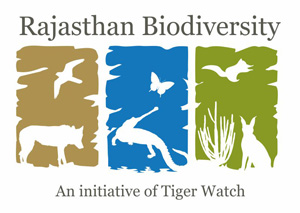

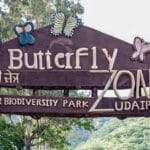
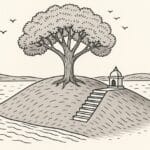
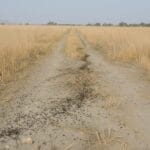
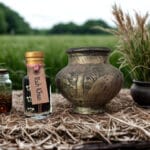
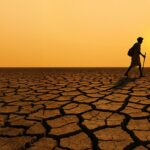

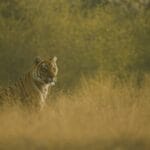
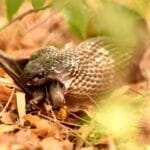
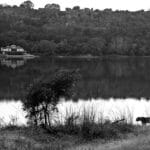
Very informative article 💚
Vey nice article sir…please send me a copy to my email dilipsharma85@gmail.com